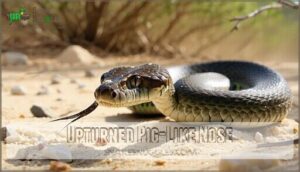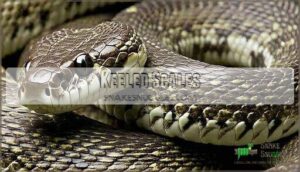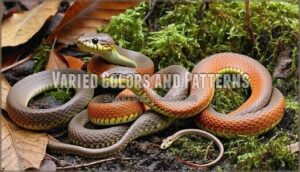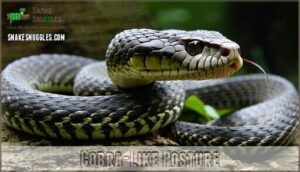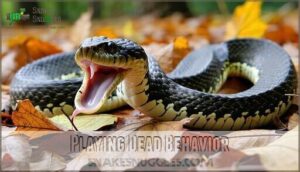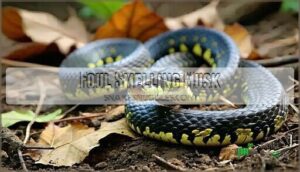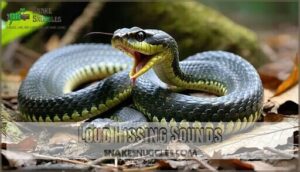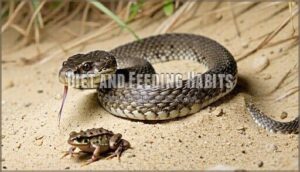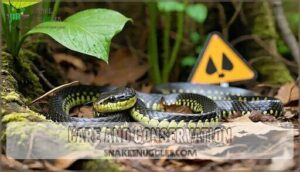This site is supported by our readers. We may earn a commission, at no cost to you, if you purchase through links.
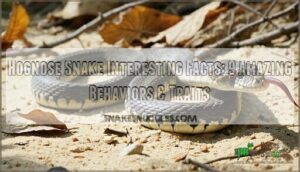
These harmless serpents excel at dramatic death scenes, flipping belly-up with tongues lolling and emitting foul-smelling musk when threatened.
Before playing dead, they’ll puff up like cobras, flatten their necks, and hiss loudly.
Their signature upturned, pig-like snouts help them dig for toads and eggs in sandy soil.
If you flip a "dead" hognose right-side up, it’ll immediately roll back over to maintain its Oscar-worthy performance.
Western, Eastern, and Southern species each display unique color patterns while sharing these remarkable defensive behaviors that make them fascinating to observe in the wild, with their ability to play dead, and their foul-smelling musk, and dramatic death scenes.
Table Of Contents
Key Takeaways
- You’ll discover hognose snakes are master actors who perform elaborate death scenes, complete with belly-up poses, lolling tongues, and foul-smelling musk to convince predators they’re already dead.
- You’ll notice their distinctive upturned, pig-like snouts aren’t just cute features—they’re specialized digging tools that help these snakes burrow through sandy soil to hunt for toads and eggs.
- You’ll find these harmless serpents use dramatic defensive displays, puffing up like cobras and flattening their necks while hissing loudly before resorting to their Oscar-worthy death performances.
- You’ll learn that different species offer fascinating variety, from compact Western hognoses to Madagascar’s impressive six-foot giants, with rare morphs like snow hognoses commanding premium prices in the pet trade.
Hognose Snake Species
You’ll find fascinating diversity among hognose snake species, from the compact western varieties to Madagascar’s impressive six-foot giants.
These remarkable reptiles include endangered dusty hognose snakes in Missouri, distinctive snow hognose variants, and the massive Malagasy giants that dwarf their American cousins, showcasing a notable diversity.
Snow Hognose Snake
You’ll discover the snow hognose snake represents the "holy grail" of western hognose snake morphs.
This double recessive morph combines albino and anerythristic genetics, creating stunning white specimens that command premium prices in the reptile trade.
- Genetics explained: Snow morphs require both parents to carry albino and anery genes
- Breeding challenges: Only 25% of offspring from het x het pairings produce snow babies
- Unique traits: Pure white coloration with pink eyes distinguishes them from other color morphs
- Albino variations: Lack both yellow and black pigments, unlike single-gene albino specimens
- Market rarity: Annual listings remain under 250 specimens across North America
These snakes, known for their docile temperament, make them suitable pets for many reptile enthusiasts.
Dusty Hognose Snake
The dusty hognose snake earns its endangered status through Missouri’s protection efforts, where habitat loss threatens this unique snake species.
You’ll find this snake pet favorite among collectors due to captive breeding programs that preserve distinct snake morphs.
Its dusty gray coloration sets it apart from other hognose snake varieties, making it a prized specimen for reptile enthusiasts.
Madagascar Giant Hognose Snake
The Madagascar giant hognose snake (Leioheterodon madagascariensis) represents island evolution at its finest, growing up to six feet long.
This unique size makes it Madagascar’s largest snake species, thriving across diverse snake habitat from rainforests to drylands.
Its snake diet includes eggs and small mammals.
Five fascinating Madagascar giant hognose snake facts:
- Unique Size – Reaches 4-6 feet, making it the giant among hognose snake species
- Island Evolution – Found across 90% of Madagascar and surrounding islands like Nosy Be
- Captive Viability – Lives 25-30 years with proper terrarium care and rodent feeding
- Conservation Needs – Listed as Least Concern but faces habitat loss threats
- Future Research – Scientists study this Leioheterodon species’ burrowing behaviors and communal nesting
When threatened, they display intimidating defensive behaviors.
Physical Characteristics
When you first spot a hognose snake, you’ll immediately notice its most distinctive feature—that upturned, pig-like snout that gives this fascinating reptile its name.
These medium-sized constrictors display remarkable physical diversity, from their textured keeled scales to their impressive range of colors and patterns that help them blend perfectly into their natural environments, showcasing their ability to adapt with remarkable physical diversity and impressive range of colors.
Upturned Pig-Like Nose
You’ll notice the hognose snake’s most distinctive feature right away – that adorable upturned snout that earned these reptiles their pig-like nickname.
The modified rostral scale creates this unique morphology, serving as more than just a cute facial feature. This specialized burrowing adaptation helps Heterodon species dig through sandy soils when hunting prey or seeking shelter.
Like other snakes, hognoses possess flexible skeletal structures that aid in movement.
| Feature | Function | Adaptation Benefit |
|---|---|---|
| Modified rostral scale | Digging tool | Efficient burrowing |
| Upturned angle | Sand displacement | Reduced digging resistance |
| Reinforced structure | Soil penetration | Enhanced durability |
| Piglike snout shape | Multi-directional scooping | Versatile excavation |
The table summarizes the key features and benefits of the hognose snake’s adaptation, highlighting its unique characteristics and advantages in its environment.
Keeled Scales
Beyond that distinctive snout, you’ll notice hognose snakes have keeled scales that create their textured appearance.
These snake characteristics aren’t just for show—each scale features a central ridge that serves multiple purposes in snake morphology.
- Scale Function: The ridge purpose includes better grip when burrowing through sandy soil
- Keeled Evolution: This snake anatomy adaptation helps with camouflage by breaking up light patterns
- Taxonomic Significance: Scale variation helps scientists identify different hognose species and subspecies
Varied Colors and Patterns
You’ll find snake appearance varies dramatically across hognose species, with color morphs ranging from earthy browns to vibrant oranges.
Regional variations create distinct colorful patterns – blonde hognose snakes showcase pale tones while others display bold spots.
These color variations serve a camouflage purpose, helping snakes blend into their environments.
The genetic basis for pattern aberrations produces fascinating snake coloration differences within populations, showcasing dramatic variations in color morphs.
Average Length and Weight
You’ll notice significant size variation across hognose species, with most measuring 14-30 inches and weighing 0.1-1.5 pounds.
Sexual dimorphism shows females consistently outgrowing males – Western females reach 36 inches while males max at 20 inches.
Growth rate varies by species, with Madagascar giants reaching 6 feet, and weight factors include genetics and captive size management through proper feeding schedules.
They’re listed as a species of "Least Concern" on the IUCN Red List.
Defensive Mechanisms
When you encounter a hognose snake in the wild, you’ll witness one of nature’s most theatrical performances as these reptiles employ multiple dramatic tactics to avoid becoming someone’s lunch.
Their defensive arsenal includes everything from convincing death scenes to intimidating cobra impersonations that would make any Broadway actor jealous, showcasing their ability to adapt and survive in their environment with dramatic tactics.
Cobra-Like Posture
When threatened, you’ll witness the eastern hognose snake‘s Oscar-worthy performance as it transforms into a fearsome cobra impersonator.
Nature’s greatest actor delivers an Emmy-worthy death scene that would fool any predator.
Through dramatic neck flattening and triangular head formation, this master of mimicry creates an intimidating threat response.
The snake defense mechanisms include loud hissing and bluff strikes with a closed mouth, proving that sometimes the best defense is a convincing bluff.
Some snakes also use aposematic coloration to warn off potential predators.
Playing Dead Behavior
When fear strikes, the eastern hognose snake transforms into nature’s greatest actor. This ultimate defense mechanism triggers dramatic physiological changes that’d make Hollywood jealous.
Here’s how this snake behavior unfolds:
- Stimulus Triggers – Perceived threats activate the playing dead response
- Physiological Changes – Heart rate slows, muscles relax completely
- Body Position – Rolls onto back, mouth agape, tongue hanging out
- Evolutionary Purpose – Convinces predators the snake’s already dead
- Captive Observation – Pet owners witness this defense mechanisms display regularly
This snake defense strategy works because most predators prefer live prey over carrion.
Foul Smelling Musk
When threatened, hognose snakes release foul-smelling musk from specialized glands near their tails as an effective predator deterrent.
When cornered, these theatrical snakes deploy their stinkiest defense—a foul musk that makes predators think twice.
This defensive behavior creates an unpleasant odor that makes them less appetizing to potential threats.
The musk composition includes sulfurous compounds that intensify during stress, serving as a powerful snake defense mechanism alongside their other dramatic defensive behaviors, which can be seen as a key defense mechanism.
Loud Hissing Sounds
When threatened, hognose snakes produce remarkably loud hissing sounds that can startle even experienced handlers.
Their defensive hiss carries impressive audible range, often heard from several feet away. Sound production involves forceful air expulsion through their glottis, creating dramatic displays.
Hissing variation depends on threat level – mild disturbances trigger soft hisses while serious threats trigger ear-splitting defensive behaviors. This predator deterrence ranks among nature’s most effective snake defenses, utilizing forceful air expulsion and dramatic displays to deter threats.
Diet and Feeding Habits
You’ll discover that hognose snakes have developed fascinating feeding strategies that make them uniquely effective hunters in their natural habitats.
Their specialized diet and hunting techniques reveal remarkable adaptations that help these snakes thrive across diverse environments from sandy plains to forest floors, making them effective hunters.
Primary Food Sources
Hognose snakes are nature’s picky eaters, showing strong Amphibian Reliance with toads making up 80% of their wild diet.
You’ll find these specialized hunters targeting frogs, small mammals, and birds.
Captive Diets require dead rodents, though Scenting Methods using frog scent help reluctant feeders accept mice.
- Toad Consumption dominates – Their upturned snouts excel at digging up buried toads in sandy soils
- Prey Size matters – They’ll wait for oversized meals to decompose rather than struggle with large prey
- Feeding preferences vary – Wild snakes show regional differences in toad diet versus frog diet ratios
Toxic Saliva and Prey Subduction
Unlike harmless garden snakes, you’ll discover that hognose snakes pack a secret weapon in their mouths.
Their venomous saliva contains specialized toxins called Duvernoy’s secretion, delivered through rear fangs.
This potent mixture subdues prey through prolonged chewing, with saliva composition featuring enzymes that break down proteins.
The toxin delivery system works exceptionally well on their preferred toad diet, neutralizing defensive chemicals that would deter other predators, making their venomous saliva a unique adaptation.
Captive Diet and Feeding Methods
In the context of snake feeding in captivity, you’ll need to replace their wild amphibian diet with frozen-thawed mice.
Adult hognose snakes typically eat appropriately-sized prey every 10-14 days, while juveniles require more frequent meals.
If your snake shows picky eating habits, try scenting techniques using frog leg or amphibian scents on mice.
Monitor feeding frequency carefully to prevent obesity – these carnivores can easily become overweight in captivity without proper portion control.
Feeding Behavior and Prey Selection
While captive snakes receive pre-killed mice, wild hognose snakes showcase remarkable foraging habits.
Their picky eating habits often target specific prey like toads, using toxic saliva to subdue victims. When prey proves too large, they’ll wait for prey decomposition rather than abandon their meal.
Understanding their diet reveals their ecological role as nature’s balance keepers.
- Toad consumption dominates their diet, with some populations getting 80% of nutrition from amphibians
- Scenting methods help captive snakes shift from live vs. dead prey preferences using frog leg extracts
- Snake feeding behavior includes patient waiting—they’ll guard decomposed prey until it’s manageable to swallow
Care and Conservation
If you’re considering a hognose snake as a pet, you’ll need to provide proper care including the right habitat setup and regular health monitoring.
Understanding their conservation status helps you make responsible ownership decisions while supporting species protection efforts, which is crucial for responsible ownership.
Habitat and Terrarium Requirements
Creating the perfect home for your Heterodon nasicus requires attention to specific details.
A 30-40 gallon enclosure size provides adequate space for adults.
Use aspen shavings or cypress mulch as substrate options for burrowing behavior.
Maintain temperature regulation with a gradient from 75-85°F, keeping humidity levels around 30-50%.
Consider the ideal enclosure products to guarantee a comfortable habitat.
Include multiple hiding spots on both warm and cool sides for security and comfort.
Health Issues and Respiratory Infections
Respiratory infections frequently plague hognose snakes, especially when humidity problems create perfect breeding grounds for bacteria.
You’ll notice symptoms like wheezing, nasal discharge, and mouth breathing that signal trouble ahead.
Antibiotic treatment from qualified veterinary care becomes essential once these snake illnesses take hold. Common ailments include pneumonia and bacterial infections that can quickly escalate without proper intervention.
Consider products for treatment if your snake shows signs of respiratory distress. Focus on infection prevention through ideal temperature control and regular enclosure cleaning to keep your snake healthy.
Conservation Status and Protected Species
Understanding hognose snake conservation status helps you appreciate their vulnerability.
Several species face serious threats from habitat loss and development pressures.
Endangered Hognoses like the southern hognose snake require federal protection consideration by 2025.
Conservation Efforts focus on habitat restoration and Species Protection through ownership restrictions in various states.
You can support hognose snake conservation by purchasing related merchandise.
Eastern hognose populations show declining trends in northeastern regions, making snake conservation increasingly important for maintaining biodiversity.
Pet Ownership and Long-Term Commitment
Why commit to a pet that might outlive your college years? Hognose snakes boast a captive lifespan of up to 20 years, making them perfect beginner-friendly companions for dedicated owners.
Essential considerations:
- Snake enclosure requirements: 30-40 gallon terrarium with proper heating
- Veterinary care costs for respiratory infections and health monitoring
- Ethical sourcing from reputable breeders guarantees healthy snake temperament
Their docile snake care needs and manageable enclosure size make these pet snakes ideal for enthusiasts ready for long-term commitment in creating the perfect snake environment.
Frequently Asked Questions (FAQs)
Why are hognose snakes so dramatic?
Like theatrical performers on nature’s stage, you’ll witness hognose snakes deploying Oscar-worthy death scenes because they’re masters of bluffing.
When threatened, they’ll flatten necks like cobras, hiss dramatically, then flip upside-down with tongues hanging out—complete with foul-smelling "death" effects to convince predators they’re unappetizing.
Do hognose snakes make good beginner pets?
Yes, you’ll find hognose snakes are excellent beginner pets. They’re docile, rarely bite, stay small, and their dramatic defensive displays are entertaining rather than dangerous, making them perfect starter snakes.
How much do hognose snakes typically cost?
You’ll pay around $100-$700 for your hognose snake, depending on the morph and breeder. Basic specimens cost less, while fancy morphs can push that higher price range.
Can hognose snakes bite humans dangerously?
Hognose snakes rarely bite humans, and when they do, their mild venom causes only minor swelling since they’re rear-fanged.
You’d experience more irritation from a bee sting than their defensive nip.
What temperature range do hognose snakes need?
Temperature control is essential for your snake’s health.
You’ll need to maintain a warm side at 88-92°F and a cool side around 78-80°F, creating that essential thermal gradient they crave.
How often should hognose snakes be fed?
Feed adult hognose snakes every 7-10 days with appropriately sized prey.
Juveniles need feeding every 5-7 days since they’re growing rapidly. You’ll adjust frequency based on your snake’s body condition and seasonal activity patterns.
Conclusion
Nature’s greatest theatrical performer transforms threat into triumph through remarkable adaptations.
You’ve discovered hognose snake interesting facts that reveal their extraordinary survival strategies – from cobra mimicry to Oscar-worthy death scenes.
These harmless serpents demonstrate how evolution crafts perfect illusions, combining dramatic flair with practical defense mechanisms.
Whether you’re observing their upturned snouts digging for prey or watching their belly-up performances, hognose snakes prove that sometimes the best defense isn’t aggression but pure theatrical genius that fools predators every time, showcasing their ability to turn threat into triumph through remarkable adaptations.
- https://potterparkzoo.org/animals/madagascar-giant-hognose-snake/
- https://www.draytonmanor.co.uk/animal-details/malagasy-hognose-snake
- https://amphibian-pug-rzk5.squarespace.com/s/MadagascarHognose-fbwn.pdf
- https://en.wikipedia.org/wiki/Hognose
- https://vetmed.illinois.edu/wildlife-blog/save-the-drama-for-your-snake-the-most-dramatic-snake/

